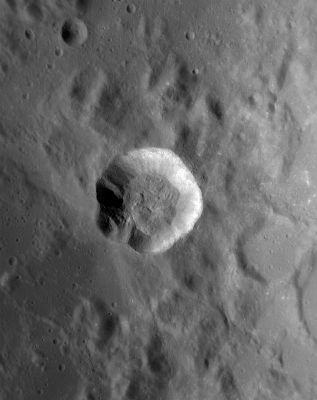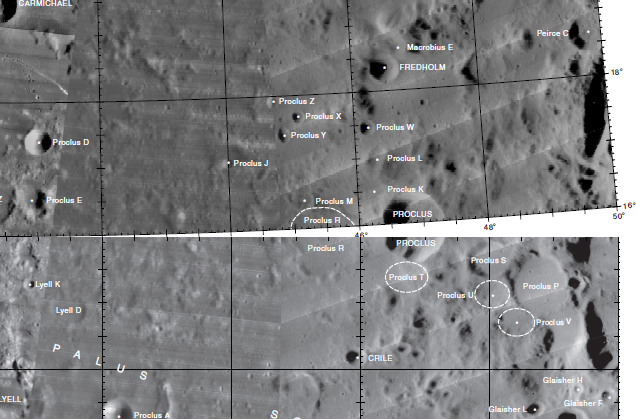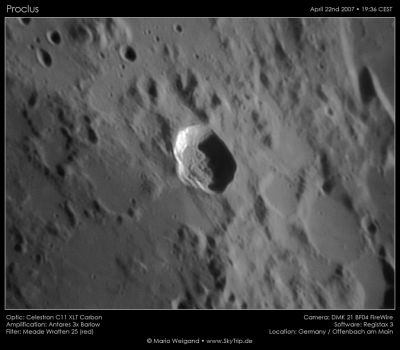Proclus
Contents
[hide]Proclus
|
Lat: 16.04°N, Long: 46.82°E, Diam: 26.91 km, Depth: 1.9 km, [/R%C3%BCkl%2026 Rükl: 26], [/Stratigraphy Copernican] | |
Table of Contents
Images
LPOD Photo Gallery Lunar Orbiter Images Apollo Images
- AS15-94-12836 shows an orbital high-sun look at Proclus and its ray system. Research: David Woods (Apollo 15 Flight Journal).
- LROC image below - WAC No. M119544139ME.

Calibrated by LROC_WAC_Previewer. - Proclus at the curved lunar horizon, captured by Apollo 10 in orbit around the moon (1969): AS10-31-4562, 4565, and 4568. Research Danny Caes
Maps
([/LAC%20zone LAC zone] 43C3) LAC map Geologic map LTO map
- IAU page: Proclus
Description
The most striking feature of Proclus is its non-continuous distribution of rays. A zone of avoidance to the east-south east is so pronouncedly dark that it Riccioli named it Palus Somni. Actually, Proclus formed by such an oblique impact, with the projectile coming from the east-southeast, that no rays were emplaced in the uprange direction, creating the Somni zone of avoidance.
Description: Elger
([/IAU%20Directions IAU Directions]) PROCLUS.--One of the most brilliant objects on the moon's visible surface, and hence extremely difficult to observe satisfactorily. It is about 18 miles in diameter, with very steep walls, and, according to Schmidt, has a small crater on its west border, where Madler shows a break. It is questionable whether there is a central mountain. It is the centre of a number of radiating light streaks which partly traverse the [/Mare%20Crisium Mare Crisium], and with those emanating from [/Picard Picard], [/Peirce Peirce], and other objects thereon, form a very complicated system.
Description: Wikipedia
Additional Information
- Depth data from [/Kurt%20Fisher%20crater%20depths Kurt Fisher database]
- Pike, 1976: 1.9 km
- Westfall, 2000: 4.04 km
- Viscardy, 1985: 2.4 km
- Cherrington, 1969: 3.62 km
- East rim slope 29° ([/Pohn%2C%201963 Pohn, 1963])
- Exterior impact melt deposits most extensive to SW ([/Hawke%20and%20Head%2C%201977 Hawke and Head, 1977]).
- Thermal anomaly crater, implying youthful age - [/Moore%20et%20al%2C%201980 Moore et al, 1980]
- Included in [/ALPO%20list%20of%20bright%20ray%20craters ALPO list of bright ray craters]
- Proclus and its satellite craters A, D, G and J are on the [/ALPO%20list%20of%20banded%20craters ALPO list of banded craters]
- Ejecta blanket with forbidden zone suggest impact angle of 10°-15°, and downrange rim height is 1 km compared to 250 m for uprange section (Forsberg, Herrick & Bussey, 1998).
- Proclus is an interesting target to observe possible reflected light on its shadowed eastern inner slopes, this during the moon's Waxing Crescent phase (one or two terrestrial days after the local sunrise at Proclus).- DannyCaes DannyCaes Apr 27, 2009 See also [/High-Albedo%20inner%20slopes High-Albedo inner slopes and reflected light]
- TSI = 20, CPI = 5, FI = 20; MI =45 [/Smith%20and%20Sanchez%2C%201973 Smith and Hartnell, 1973]
- V.A. Firsoff noticed a sudden brightening of Proclus on the 8th of September 1954 (about 20h U.T.), as observed through a blue Dufay tricolour separation filter (source: The Old Moon and the New, V.A. Firsoff, page 183).
- R. Parry and others observed variations in the shape of the northwestern ray of Proclus, see page 160 in Volume 1 of T.W. Webb's Celestial Objects for Common Telescopes.
Nomenclature
- Named for [/Proclus%20Lycaeus Proclus Lycaeus] (February 8, 412 – April 17, 485), surnamed "The Successor" or "Diadochos", a Greek Neoplatonist philosopher, one of the last major Greek philosophers. Also, an astronomer - he is reported to have made "the last astronomical observation in the ancient Greek world in AD 475." C. Freeman (2002) The Closing of the Western Mind, p. XIX. - tychocrater tychocrater Jul 26, 2007
- According to [/Whitaker Whitaker] (p. 196), this crater was labeled Puteani by [/Langrenus Van Langren]; and later apparently labeled Mons Corax by [/Hevelius Hevelius] (p. 203), who depicted it with a ring of peaks on his nomenclature map, but Hevelius seems to have repeated the same name to the south, near the northeast shore of the modern [/Mare%20Fecunditatis Mare Fecunditatis], so it unclear exactly what he meant by it.
- The present name was introduced on [/Riccioli Riccioli]'s map ([/Whitaker Whitaker], p. 214), and has continued unchanged since then.
- Near Proclus P is the site of the so-called O'Neill's Bridge (see [/Promontorium%20Olivium Olivium]).
- Also somewhere in this vicinity should be a couple of surface formations which were once called Flying eagle and Eagle gate. These two nicknames appeared in the article Illusions that Trap Lunar Observers by Leland S. Copeland; Sky and Telescope April 1956, pages 248-251. Research Danny Caes.
LPOD Articles
Lunar 100
[/Lunar%20100 L12]: Oblique-impact rays.
Lettered Craters

Mosaic image of LAC 43 and LAC 61. Excerpt from the USGS Digital Atlas of the Moon.
Bibliography
- "Bridge of O'Neill": [/Wilkins%20and%20Moore The Moon] by H.P. Wilkins and P.Moore.
- APOLLO OVER THE MOON; A VIEW FROM ORBIT, Chapter 5: Craters (Part 4), Figure 147.
[/Alphabetical%20Index Named Featues] -- Prev: [/Oceanus%20Procellarum Oceanus Procellarum] -- Next: [/Proctor Proctor]
This page has been edited 1 times. The last modification was made by - tychocrater tychocrater on Jun 13, 2009 3:24 pm - afx3u3

